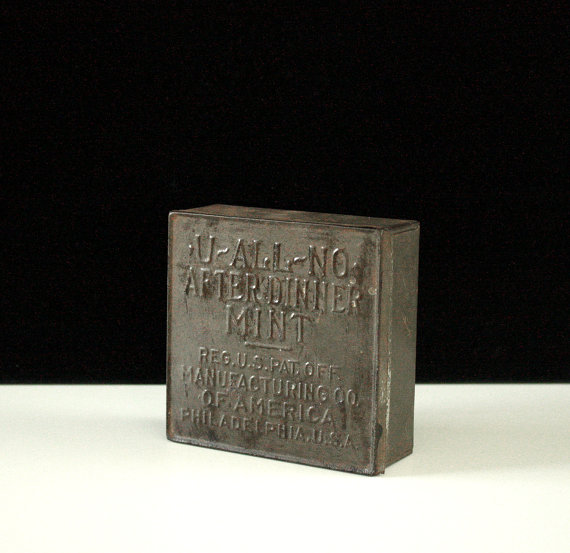U All No, from the Hidden City blog's post about the inscribed brick smokestacks of the Philadelphia area.
I spend a lot of time on the Amtrak, shuttling between New York and Philadelphia, and one of the many delights of that stretch of the Northeastern rail corridor is this smokestack on the outskirts of Philly:
There is something hauntingly defiant about this disused smokestack. From its cacographic "U" to its punning reduction of "know" to "no," I've always been cheered by its persistent spouting of this little bit of near-nihilism up in the Northern fringe of the city.
But what is it about?
"U All No" was an after-dinner mint produced by the Manufacturing Company of America. It turns out that they played a critical role in the US war effort during the First World War.
I'm not sure when exactly the Manufacturing Company of America started making the mints, but the company registered their trademark for the words "U All No" on June 5, 1906.
Candy was a big deal in the Progressive era, as sugar consumption among Americans spiked, and as temperance activists promoted candy-eating as a sober alternative to the temptations of demon liquor -- or even as a substitute for it, satisfying the same cravings. As A.C. Abbott, Pennsylvania's state health commissioner, put it: "The appetite for alcohol and the appetite for candy are fundamentally the same." (For more on this, check out Jane Dusselier's essay on candy-eating and gender in the collection Kitchen Culture in America.)
In the wake of the 1906 Pure Food and Drug Act, modern candy makers emphasized the scientific purity of their products. "U All No" mints even made the 1907 Good Housekeeping Pure Food "Roll of Honor." The magazine noted:
"Made in a peculiarly cleanly manner, mostly by machinery, from cane sugar and ingredients chemically tested for purity and uniformity. This firm maintains a specially equipped laboratory, in charge of a graduate chemist of the University of Pennsylvania, where critical tests are made of every material entering into the candy."
However, the reason these mints helped win the war was not because of their ability to divert Americans from the intoxications of booze to the intoxications of sugar, nor because of their invigorating freshness, nor because of the lab-certified purity of their production.
It was all about the tins.
When the US entered the First World War, they faced the problem of transporting American-factory-built fuses and detonators 4,000 miles or more, over land and sea, to the front lines. Fuses are fragile and persnickety. Moist air can cause a detonator mechanism to malfunction. As William Bradford Williams put it, rather ghoulishly, in Munitions Manufacture in the Philadelphia Ordnance District (1921):
"A dampened fuse when placed in a projectile results in a 'dud,' and a dud never raised the mortality rate of the German soldiery."
The Manufacturing Company of America had faced a very similar problem when they contrived to deliver their mints as fresh as the day they were made to the post-prandial candy-cravers of these United States, leading to the development of a box that was "absolutely air-tight and moisture-proof.... hermetically sealed against light, water, dust and air."
Good enough to suit the needs of Army Ordnance, and deliver minty-fresh fuses and detonators to the front.
According to Williams, the Manufacturing Company of America allowed the government to take over the production line at the U-All-No plant, modifying the process to built tins large enough to fit detonators for "high-capacity drop bombs" and fuses for Livens flame-throwers. They continued to made mints, though, for our boys in the army. Quoth Williams: "A large part of the firm's U-All-No After Dinner Mint was taken over by the government to supply the insatiable demands of our boys overseas for a few of those delicacies to which they had become accustomed at home."
